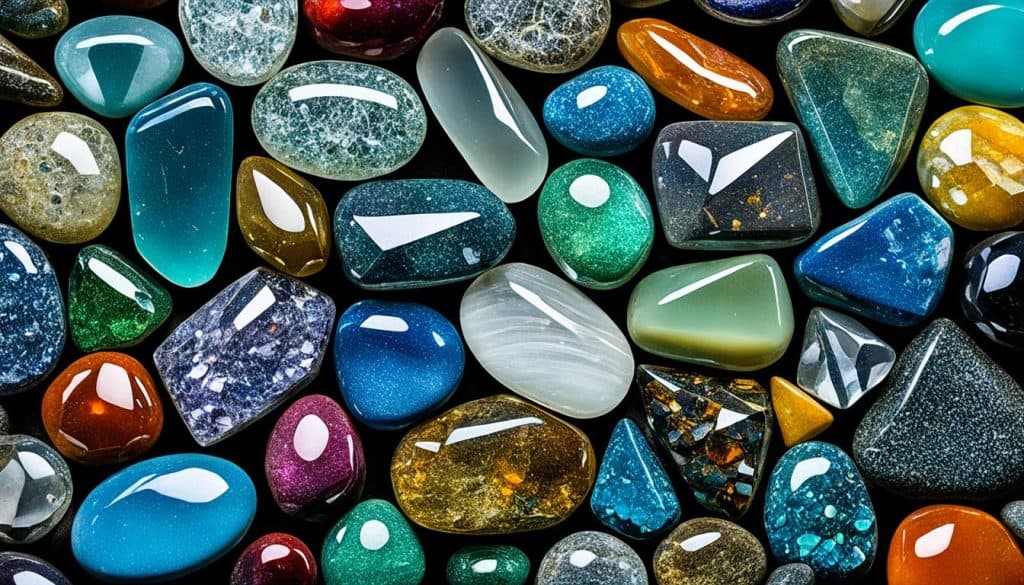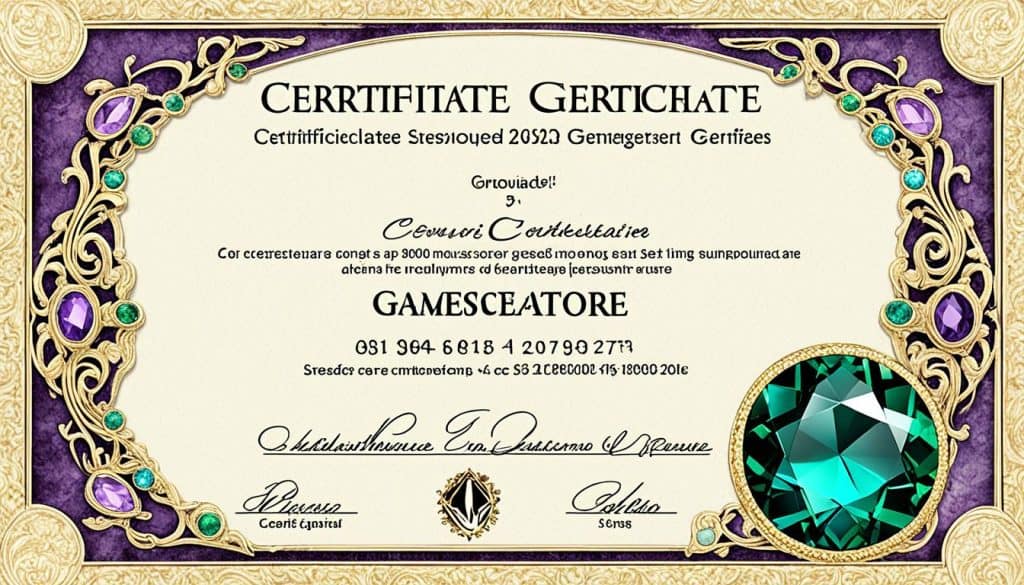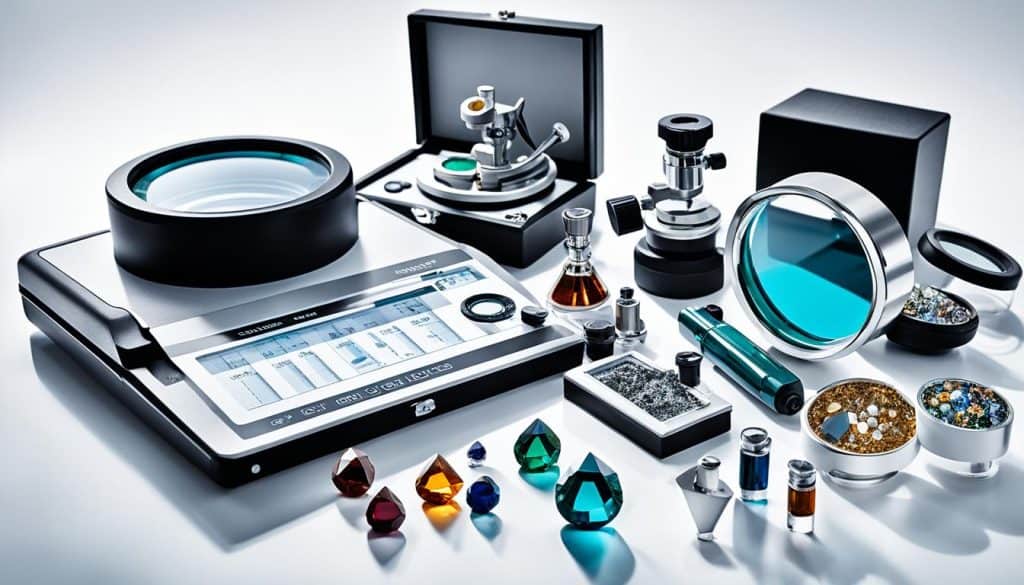I was searching for the perfect gemstone jewelry piece and was drawn to their beauty. Each gemstone seemed to tell a unique story with its colors and sparkle. But, I soon learned not all stones are the same.
Many fake gemstones are out there, pretending to be real. It’s hard to tell what’s real and what’s not, from synthetic to imitations. As a buyer, it’s key to check if a gemstone is genuine. This protects your investment and keeps the gemstone’s true value.
This guide will help you understand how to spot genuine gemstones. We’ll cover how to check for authenticity, appraisal tips, and what certifications mean. This way, you can pick a gemstone that truly speaks to you.
We’ll look at different fake gemstones, like synthetic ones made in labs or imitations that look real. We’ll learn how to spot real gemstones by looking at them, testing them, and using advanced tools.
We’ll also explore antique gemstones and their secrets. From diamonds to pearls, we’ll see how to tell if they’re real and what makes them special.
Then, we’ll dive into gemstone jewelry. We’ll see how birthstones reflect your personality and how certain gemstones are believed to bring luck. You’ll learn about the beauty and meaning of opal, aquamarine, garnet, and moldavite jewelry.
If you love gemstones, jewelry, or just admire their beauty, join me. Let’s discover the truth about genuine gemstones. Together, we’ll make sure every gemstone you find is truly special.
Common Types of Fake Gemstones
There are three main types of fake gemstones: synthetic, imitations, and treated gemstones. Knowing the differences between them helps buyers make smart choices and check if a gemstone is real.
Synthetic Gemstones
Synthetic gemstones look just like natural ones but are made in labs. They can be diamonds, rubies, sapphires, or emeralds. These stones are hard to tell apart from real ones without expert help.
Imitation Gemstones
Imitation gemstones aren’t made from minerals. They’re often glass, plastic, or resin. They look like real gemstones but aren’t the same. For example, plastic can look like amber, but real amber has unique features.

Treated Gemstones
Treated gemstones are natural ones that have been made better. They might be heated, colored, or fixed up. These changes make them look nicer. But, it’s key to know that these changes are allowed by rules.
When buying gemstones, think about their size, color, clarity, and shape. Getting expert advice and certificates can help spot real gemstones. Tests like hardness tests and color checks can also tell if a gemstone is real.
Knowing about fake gemstones helps buyers choose the best ones. This way, you can pick high-quality, real gemstones.
Identification of Genuine Gemstones
Gemologists use several methods to check if a gemstone is real. One key test is the hardness test. It checks how well a gemstone resists scratches using the Mohs scale. This tells us about the stone’s strength and hardness.
Color and light analysis is also vital. Gemstones come in many colors and react differently with light. Experts look at the gemstone’s color, how clear it is, and how it reflects light. They use special tools to tell real gemstones from fake ones.
Heat testing helps tell diamonds from fake ones. Diamonds don’t change much when heated, unlike fake ones. This method is useful for identifying diamonds.
It’s best to talk to a gemologist for a gemstone’s true identity and value. Gemologists know how to check a gemstone’s realness with their skills and tools. They also look at the gemstone under a microscope. A gemstone certificate from a trusted lab gives more proof of its realness.

Gemstone Authentication and Professional Appraisal
Gemstone authentication is key in checking the gem’s credibility and quality. Professional gemologists use special techniques and tools for this. They make sure the gemstone is real, of high quality, and from where it says it is.
Visual inspection is a main way to check gemstones. Gemologists look closely at the gemstones for marks, flaws, and color changes. These signs can tell a lot about the gemstone’s realness and quality.
Refractive index testing is also vital. It measures how a gemstone changes light. By comparing this to known values, gemologists can spot if the gemstone is real or not. This method also finds out if the gemstone has been treated.
Checking the gemstone’s specific gravity and density is also important. Gemologists weigh the gemstone and compare it to known values. This confirms the gemstone’s realness.
Professional gemologists use special equipment for accurate checks. They use techniques like spectroscopy, microscopy, and X-ray analysis. These help identify gemstones, check if they are real, and see their quality.
Licensed labs like the Gemological Institute of America (GIA) and the American Gemological Laboratories (AGL) are trusted for gemstone checks. They have strict processes for checking and documenting gemstones. This ensures accurate and quality checks.
Gemstone certificates from these labs are official proof of a gemstone’s details, quality, and realness. They are important for insurance, appraisals, and investment. These certificates tell about the gemstone’s weight, color, clarity, and any treatments it had.
Sellers gain from offering certified gemstones too. It builds their trust and reputation. Certified gemstones are more attractive to buyers because they are sure of their quality and realness. They also sell for more money, drawing in more buyers.
Knowing how to read gemstone certificates helps buyers and sellers. Certificates from trusted labs like the GIA and AGL follow strict standards. This makes the certificates reliable and accurate.

Gemstone Examination Techniques
Authenticating gemstones is crucial, and it involves looking closely and measuring them. Gemstone experts use various methods to check their true nature and value. Let’s look at some key techniques used in the field.
Visual Examination
Looking closely at a gemstone’s color, clarity, and inclusions is key. Experts use jeweler’s microscopes and loupes for this. The type and location of inclusions can tell a lot about the gemstone.
Physical Measurements
Measuring a gemstone’s properties is vital for its quality check. Experts use tools for tests like:
- Hardness Testing: This shows how well a gemstone resists scratches, helping to tell gem types apart.
- Refractive Index Measurement: This tells us how light behaves inside the gemstone, which helps identify its optical traits.
- Dispersion Examination: This measures how a gemstone spreads light into colors, helping to spot certain types.
- Specific Gravity and Density Calculations: These help figure out a gemstone’s density, which is useful for telling them apart.
Gemstone Treatments
Many gemstones get treated to look better. These treatments include heat, diffusion, and irradiation. It’s important to know about these treatments during an examination. They can affect a gemstone’s real value and appeal.
By using visual checks, physical measurements, and gemstone treatment knowledge, experts can accurately judge a gemstone’s quality. This helps them figure out its value and make sure it’s genuine.
Difference between Artificial and Natural Gemstones
There are two main types of gemstones: artificial and natural. Knowing the difference is key for anyone looking to buy or value gemstones.
Natural Gemstones: Rarity and Value
Natural gemstones take millions or billions of years to form deep inside the Earth. This process makes them rare and valuable. High-quality natural gemstones are the most sought after, even more than synthetic ones.
When looking at natural gemstones, consider their color, clarity, and cut. These factors add to their beauty and value.
About 95% of rubies and blue sapphires in the market are treated to improve their quality. This makes them better for jewelry. Some emeralds are also treated to look better.
For gemstones like ruby, sapphire, and emerald, ask for a lab certificate if you spend over $1000. This proves the gemstone is real.
Artificial Gemstones: Creation and Characteristics
Artificial gemstones, or synthetic ones, are made in labs or factories. They form much faster than natural ones, in days to a year.
These gemstones look just like natural ones but can be more colorful and clear. They’re popular for being affordable and consistent in quality.
Creating synthetic gemstones involves different methods. The Flame Fusion method started in the late 1800s and made the first synthetic rubies. The Flux Growth method came later and makes better quality gems but costs more.
There are also gemstone simulants that look like natural ones but aren’t chemically the same.
Final Thoughts
Synthetic gemstones are cheaper and consistent, but natural ones are rare and beautiful. They can also increase in value over time, making them a good investment.
At Gemdaia, we value natural, ethically mined gemstones for their uniqueness and sustainability. Many people struggle to tell real from fake gemstones because they look so similar.
About 50% of gemstone purchases include lab tests to check if they’re real. Yet, 30% of synthetic gemstones are still hard to spot because they’re so similar to natural ones.
Even though most gemstones are made artificially, more people are looking for ethical options. Some support small-scale miners who mine natural gemstones responsibly, reducing harm to the environment.
In conclusion, knowing the difference between artificial and natural gemstones is important when buying or evaluating them. Whether you like the rarity and value of natural stones or the affordability of synthetic ones, both have their own appeal.
Conclusion
Ensuring gemstone authenticity is key to knowing their true value. Using methods like visual checks, measuring, and expert appraisals helps tell real from fake. Getting a gemstone certified by experts is vital for trustworthiness.
Knowing the difference between real and fake gemstones is crucial for smart buying. Real gemstones have unique flaws that set them apart from fakes. This knowledge helps in making better choices.
Tests like light tests, hardness checks, and specific gravity tests help spot real gemstones. Talking to experts and trusted jewelers also boosts the chances of getting authentic stones.
To sum up, checking gemstones involves visual checks, expert stamps, and detailed tests. It’s wise to work with certified gemologists and buy from trusted sellers. This way, you can be sure of getting high-quality, genuine gemstones.
